Plant managers often face costly measurement errors with traditional flow technologies in steam and gas applications. Vortex flow meters offer reliable alternatives with minimal maintenance needs.
Vortex flow meters provide 4 key advantages: 1) No moving parts for 100,000+ hour lifespans, 2) ±1% accuracy for liquids/gases/steam, 3) Wide 10:1 turndown ratio, and 4) Lower cost than competing technologies. Their simple principle measures vortex shedding frequency proportional to flow velocity.
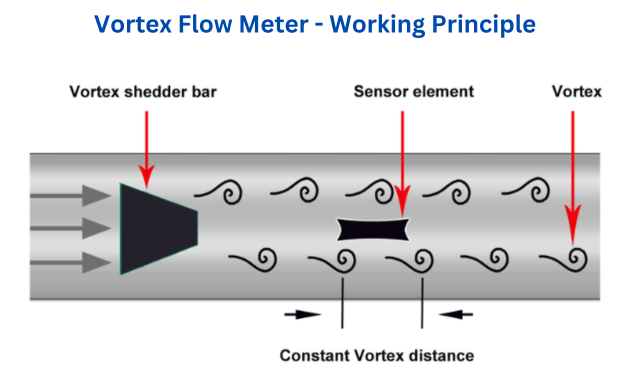
Vortex Shedding Diagram
Understanding both strengths and weaknesses ensures proper meter selection for your specific application.
What Are the Advantages of Vortex Flow Meter?
Six operational benefits driving industrial adoption:
Performance Comparison Table
| Advantage | Impact | Typical Value |
|---|---|---|
| No moving parts | Maintenance reduction | 90% less than mechanical meters |
| Wide fluid compatibility | Application flexibility | Handles steam, gases, liquids |
| Linear output | Measurement consistency | ±0.65% of rate (liquids) |
| Bidirectional flow | Installation flexibility | Equal accuracy both directions |
| Temperature range | Harsh environment use | -40°C to 400°C standard |
| Pressure rating | High-pressure service | ANSI 900# flange options |
Key Application Strengths
- Steam Measurement – Saturated & superheated
- Compressed Air – No lubrication needed
- HVAC Systems – Energy monitoring
- Chemical Processing – Corrosion-resistant options
- Oil & Gas – Explosion-proof designs
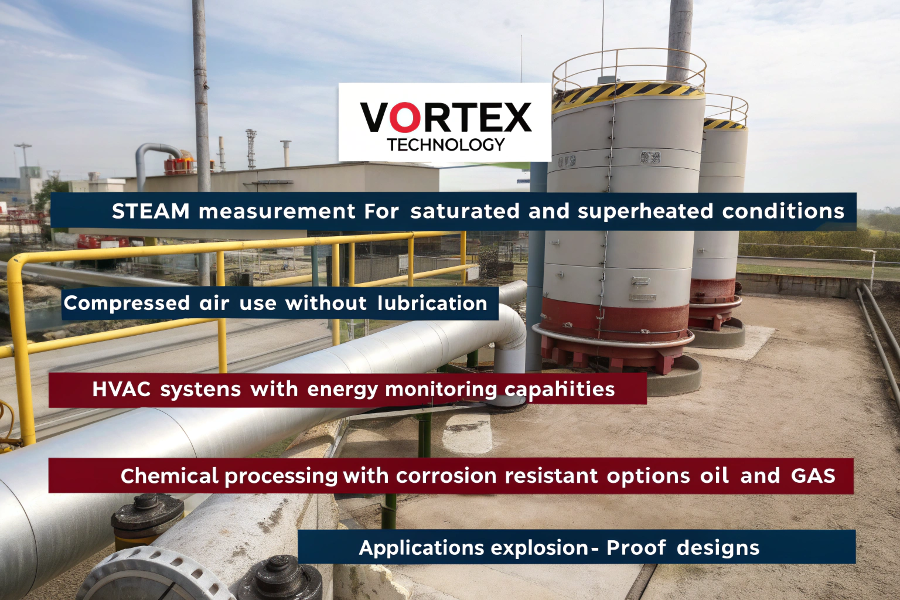
Industrial Use Cases
Economic Benefits
- 40-60% lower lifetime cost vs. DP meters
- 5-year calibration intervals
- Minimal straight pipe requirements
- No impulse lines to maintain
What Are the Disadvantages of Vortex?
Five critical limitations requiring consideration:
Performance Constraints
| Limitation | Effect | Workarounds |
|---|---|---|
| Minimum flow velocity | Measurement cutoff | Alternate technologies below 0.3 m/s |
| Vibration sensitivity | Signal interference | Isolation mounts, digital filtering |
| Pipe size limits | Range constraints | Alternate devices above DN300 |
| Fluid viscosity | Performance degradation | Not recommended for >30 cP |
| Pressure drop | Energy loss | Proper sizing minimizes impact |
Problematic Installations
- Pump Discharge Lines – Vibration interference
- Two-Phase Flow – Erratic readings
- Dirty Fluids – Shedder bar buildup
- Pulsating Flow – Measurement errors
- Non-Newtonian Fluids – Unpredictable shedding
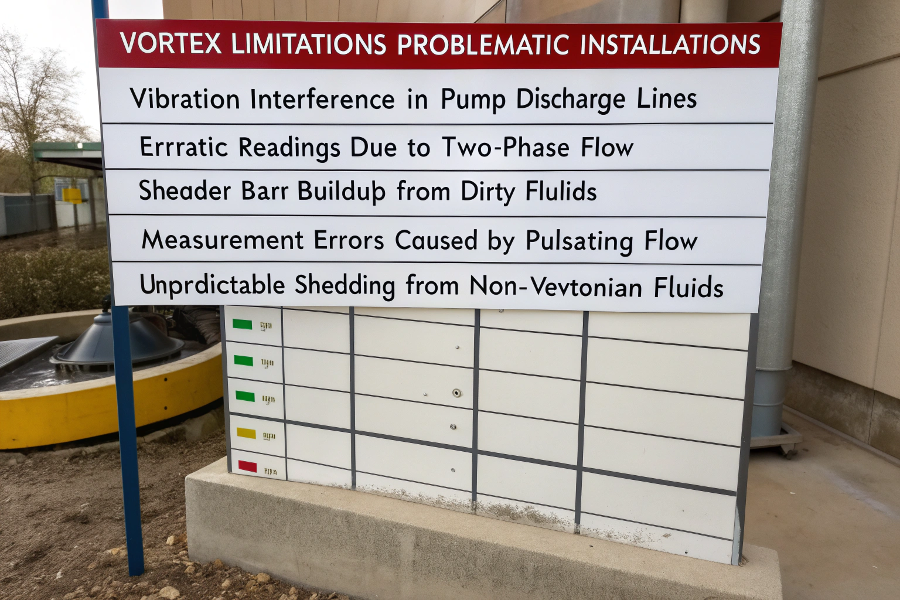
Constraint Analysis
Cost Considerations
- Higher initial cost than most mechanical meters
- Special requirements for hazardous areas
- Limited retrofit applications
- Cleaning challenges in sanitary service
What Are the Limitations of Vortex Flowmeter?
Three fundamental technical boundaries:
Physics-Based Constraints
-
Karman Street Requirements
- Requires minimum Reynolds number (Re > 10,000)
- Fails in laminar flow conditions
- Velocity profile sensitive
-
Energy Considerations
- 0.1-0.5 bar permanent pressure loss
- Flow energy diverted to create vortices
- Minimum velocity threshold
-
Structural Factors
- Shedder bar mechanical stress limits
- Vibration fatigue considerations
- Temperature cycling effects
Application-Specific Limits
| Industry | Challenge | Solution |
|---|---|---|
| Water | Low conductivity fluids | Alternative technologies |
| Oil | High viscosity liquids | Coriolis meters |
| Food | Cleaning requirements | Sanitary designs |
| Pharma | Sterilization needs | CIP/SIP versions |
| Mining | Abrasive slurries | Not recommended |
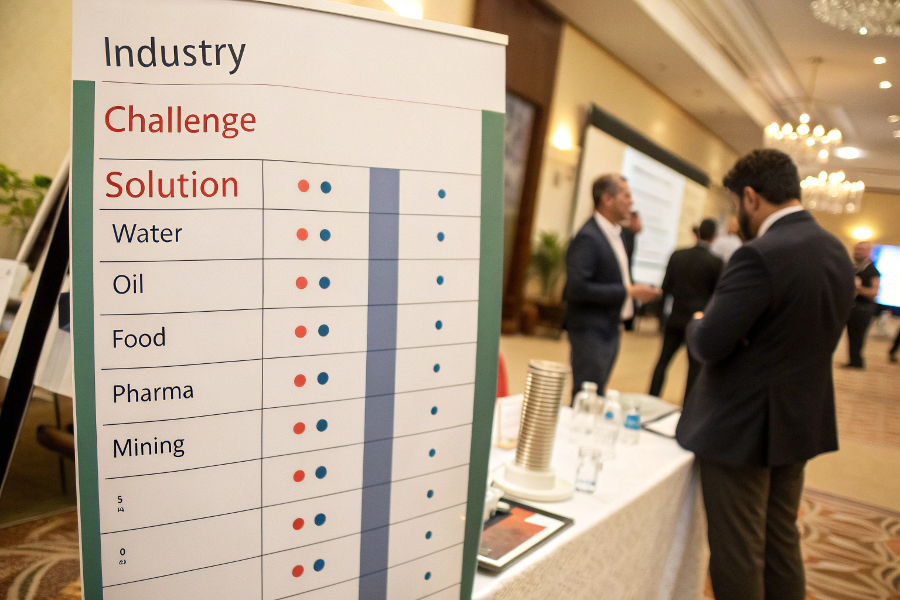
Physics Limitations
Emerging Technology Gaps
- No multiphase flow capability
- Limited smart diagnostics
- Challenging for custody transfer
- Difficult low-flow verification
- RFI/EMI sensitivity issues
What Are the Drawbacks of Vortex Formation?
Four unexpected operational impacts:
Process Interference Issues
-
Acoustic Noise Generation
- Audible frequencies in gas service
- Pipe resonance concerns
- Vibration transfer
-
Material Stress Factors
- Fatigue at weld points
- Cavitation risk downstream
- Erosion-corrosion potential
-
Flow Profile Distortion
- Downstream turbulence
- Mixing effects
- Velocity profile changes
-
Energy Conversion Losses
- Permanent pressure drop
- System efficiency reduction
- Pumping cost increases
Mitigation Strategies
- Proper upstream straight runs (20D)
- Anti-vibration pipe supports
- Streamlined shedder designs
- Pressure recovery accessories
- Multi-sensor averaging
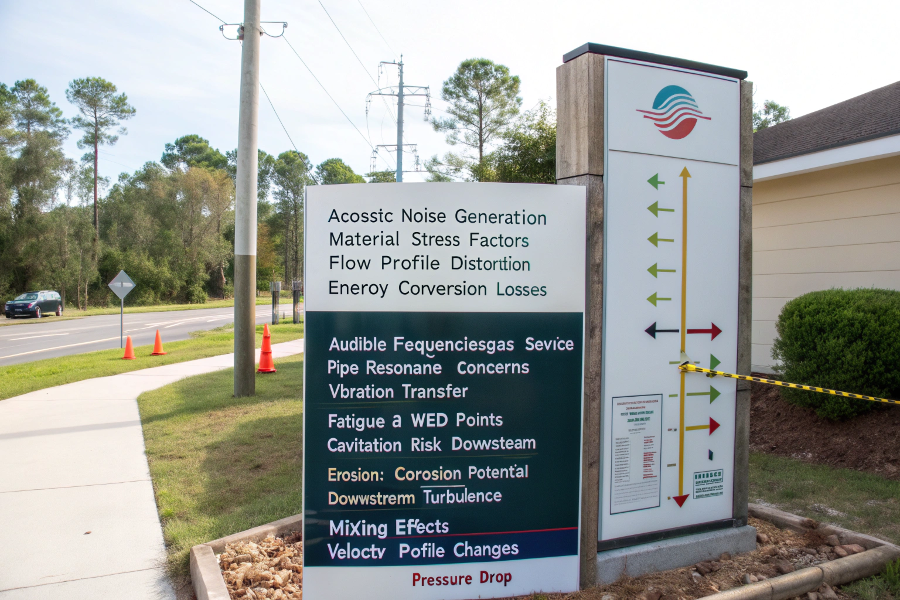
Flow Disruption Analysis
Maintenance Consequences
- Shedder bar inspection requirements
- Gasket leakage points
- Sensor fouling monitoring
- Electronics calibration drift
- Grounding system checks
Conclusion
Vortex flow meters deliver reliable, cost-effective measurement for many industrial liquid, gas and steam applications while requiring minimal maintenance. However, their fundamental operating principle imposes necessary limitations – particularly regarding minimum flow rates, vibration sensitivity and fluid viscosity. Understanding both the advantages and constraints enables proper technology selection, avoiding measurement problems while maximizing the benefits of vortex shedding principles in appropriate applications. Recent design improvements continue expanding their viable operating envelope while maintaining their core economic and reliability benefits.
